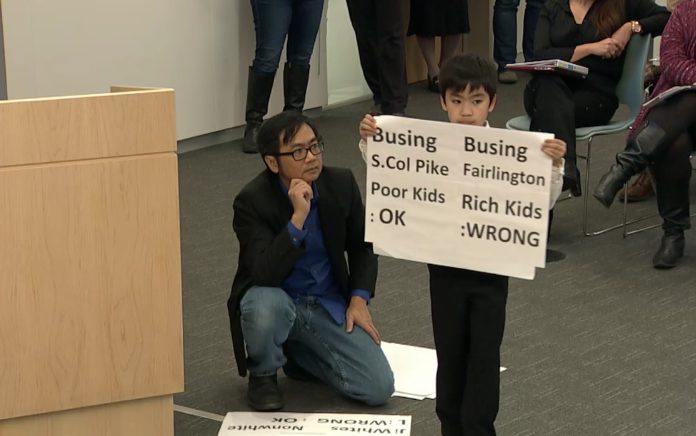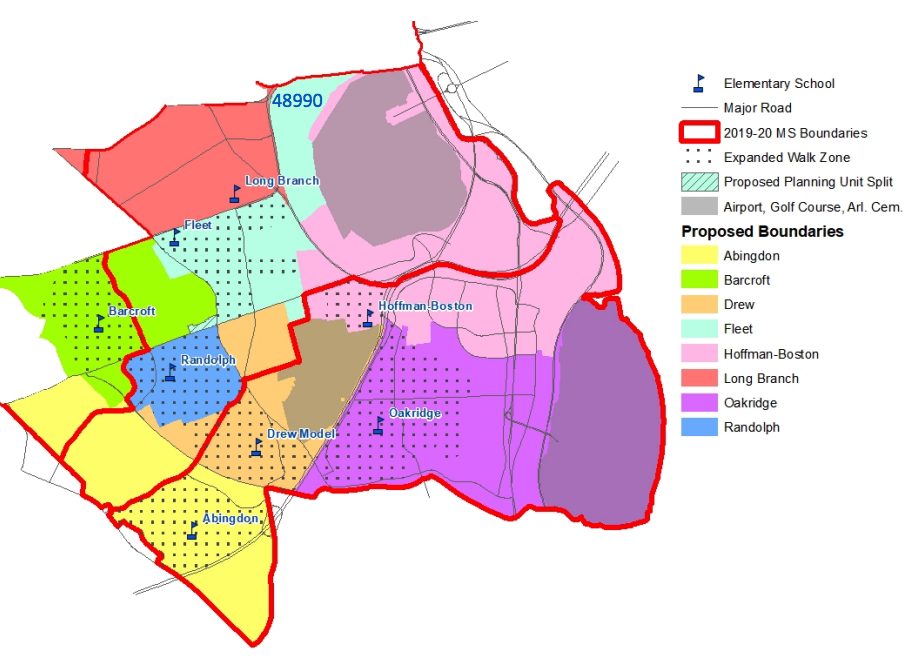Eight South Arlington elementary schools will soon see changes to their attendance boundaries, now that the School Board has signed off on a final map and put an end to a contentious, messy debate over boundaries that roiled several school communities over the last few months.
The Board voted unanimously last night (Thursday) to approve a boundary map drawn up by school officials just a few days ago, a move that could send as many as 413 elementary students to new schools starting next year.
Arlington Public Schools officials designed the boundary process to meet a series of different concerns. Not only is the school system facing rising enrollment numbers across all of its schools, but officials needed to account for the opening of Alice West Fleet Elementary School next year. The school system is also gearing up to convert Drew Model School into a “neighborhood” school, drawing its attendees primarily from the communities surrounding the Nauck building, and move its Montessori program to the building currently serving as Patrick Henry Elementary.
Accordingly, the process involved drawing new boundaries for both Drew and Fleet, while shifting some students primarily from Oakridge and Long Branch to those schools, as well as Hoffman-Boston.
But APS leaders and Board members have come under fire from virtually all sides as they’ve managed this complex series of moves.
Many parents at Henry felt betrayed by proposals that would send roughly a fifth of the community to Drew instead of Fleet, even though they felt school officials had long promised to avoid such a change. Others at Drew fretted that the boundary changes wouldn’t do enough to even out demographics at each South Arlington school, while Abingdon parents were alarmed by a prior proposal to move some students in Fairlington to Drew instead.
Even still, Board members expressed confidence that the map they’ve approved will best serve the needs of the entire school system, despite the acrimony that marred the process.
“It’s a solution we need to have happen at this point because of our rising enrollment,” said Board Chair Reid Goldstein. “This boundary change is not perfect. No boundary change is perfect.”
Yet plenty of parents arrived at Thursday’s meeting to decry the entire process, with many lamenting that the Board has managed to break their trust that future efforts will be managed competently.
“You’re failing Drew and Fleet,” parent Susan Hampton told the Board. “I don’t know why you’d willfully increase economic segregation… I’ve lost my faith in the process.”
Notably, even some Board members expressed regret that they couldn’t do enough to better spread out students eligible for free and reduced price lunch (a key indicator of their family’s economic means) across the eight schools. While the new map will reduce FRL rates at some schools, Barcroft, Drew and Randolph will all still have at least 50 percent of their student bodies eligible for free and reduced lunch.
“I certainly didn’t meet all the goals we laid out for this,” Goldstein said.
But Board member Monique O’Grady argued that the new map still took major steps toward addressing racial inequality in the county, primarily with how it will transform Drew’s future. She noted that the Nauck community has long hoped for a “single-focus neighborhood school,” though students there have been constantly bused away from the area, dating back to the days of the Jim Crow era.
While some parents at Henry proposed transforming Drew into a countywide “option” program as one way to avoid more boundary changes elsewhere, O’Grady stressed that converting Drew into a pure neighborhood school is the best way to meet the community’s needs.
“Now Drew will follow in the footsteps of Oakridge and Abingdon… which now enjoy huge support from the families they serve,” O’Grady said. “I believe Drew will enjoy similar success.”
Other parents were similarly pleased that the Board’s map will keep the entirety of the Fairlington community together at Abingdon, even though it will leave the school a bit overcrowded for now. The Board chose to leave some schools a bit under-capacity — including Fleet and Drew — to allow for growth over the years, and avoid more boundary changes. Then, it hopes to address any remaining issues in the 2020 boundary drawing process.
“[This map] acknowledges that our neighborhoods continue to fill with elementary-aged children who want to take advantage of our excellent schools, and gives our county and our kids room to grow,” said Claire Rosenberger, an Abingdon parent.
But many remain nervous that the 2020 changes will proceed similarly turbulently, and warned parents to be vigilant moving forward.
“Successful civic engagement does not require that everyone agree with end result, but it does require transparency and accountability,” said Joe Everling, a Henry parent who has been fiercely critical of the Board’s process. “To my utter amazement, that has not happened here… there is no oversight for this board, except for the citizen voter.”



